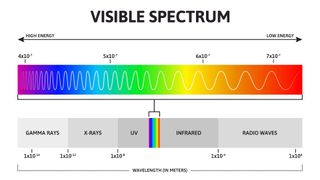
Can anything travel faster than the speed of light?
Does it matter if it's in a vacuum?

In 1676, by studying the motion of Jupiter's moon Io, Danish astronomer Ole Rømer calculated that light travels at a finite speed. Two years later, building on data gathered by Rømer, Dutch mathematician and scientist Christiaan Huygens became the first person to attempt to determine the actual speed of light, according to the American Museum of Natural History in New York City.
Huygens came up with a figure of 131,000 miles per second (211,000 kilometers per second), a number that isn't accurate by today's standards — we now know that the speed of light in the "vacuum" of empty space is about 186,282 miles per second (299,792 km per second) — but his assessment showcased that light travels at an incredible speed.
According to Albert Einstein's theory of special relativity, light travels so fast that, in a vacuum, nothing in the universe is capable of moving faster.
"We cannot move through the vacuum of space faster than the speed of light," confirmed Jason Cassibry, an associate professor of aerospace engineering at the Propulsion Research Center, University of Alabama in Huntsville.
Question answered, right? Maybe not. When light is not in a vacuum, does the rule still apply?
Related: How many atoms are in the observable universe?
"Technically, the statement 'nothing can travel faster than the speed of light' isn't quite correct by itself," at least in a non-vacuum setting, Claudia de Rham, a theoretical physicist at Imperial College London, told Live Science in an email. But there are certain caveats to consider, she said.
Light exhibits both particle-like and wave-like characteristics, and can therefore be regarded as both a particle (a photon) and a wave. This is known as wave-particle duality.
If we look at light as a wave, then there are "multiple reasons" why certain waves can travel faster than white (or colorless) light in a medium, de Rham said. One such reason, she said, is that "as light travels through a medium — for instance, glass or water droplets — the different frequencies or colors of light travel at different speeds."
The most obvious visual example of this occurs in rainbows, which typically have the long, faster red wavelengths at the top and the short, slower violet wavelengths at the bottom, according to a post by the University of Wisconsin-Madison.
Sign up for the Live Science daily newsletter now
Get the world’s most fascinating discoveries delivered straight to your inbox.
When light travels through a vacuum, however, the same is not true.
"All light is a type of electromagnetic wave, and they all have the same speed in a vacuum (3 x 10^8 meters per second). This means both radio waves and gamma rays have the same speed," Rhett Allain, a physics professor at Southeastern Louisiana University, told Live Science in an email.
So, according to de Rham, the only thing capable of traveling faster than the speed of light is, somewhat paradoxically, light itself, though only when not in the vacuum of space. Of note, regardless of the medium, light will never exceed its maximum speed of 186,282 miles per second.
Universal look
According to Cassibry, however, there is something else to consider when discussing things moving faster than the speed of light.
"There are parts of the universe that are expanding away from us faster than the speed of light, because space-time is expanding," he said. For example, the Hubble Space Telescope recently spotted 12.9 billion year-old light from a distant star known as Earendel. But, because the universe is expanding at every point, Earendel is moving away from Earth and has been since its formation, so the galaxy is now 28 billion light years away from Earth.
In this case, space-time is expanding, but the material in space-time is still traveling within the bounds of light speed.
Related: Why is space a vacuum?

So, it's clear that nothing travels faster than light that we know of, but is there any situation where it might be possible? Einstein's theory of special relativity, and his subsequent theory of general relativity, is "built under the principle that the notions of space and time are relative," de Rham said. But what does this mean? "If someone [were] able to travel faster than light and carry information with them, their notion of time would be twisted as compared to ours," de Rham said. "There could be situations where the future could affect our past, and then the whole structure of reality would stop making sense."
This would indicate that it would probably not be desirable to make a human travel faster than the speed of light. But could it ever be possible? Will there ever be a time when we are capable of creating craft that could propel materials — and ultimately humans — through space at a pace that outstrips light speed? "Theorists have proposed various types of warp bubbles that could enable faster-than-light travel," Cassibry said.
But is de Rham convinced?
"We can imagine being able to communicate at the speed of light with systems outside our solar system," de Rham said. "But sending actual physical humans at the speed of light is simply impossible, because we cannot accelerate ourselves to such speed.
"Even in a very idealistic situation where we imagine we could keep accelerating ourselves at a constant rate — ignoring how we could even reach a technology that could keep accelerating us continuously — we would never actually reach the speed of light," she added. "We could get close, but never quite reach it."
Related: How long is a galactic year?
This is a point confirmed by Cassibry. "Neglecting relativity, if you were to accelerate with a rate of 1G [Earth gravity], it would take you a year to reach the speed of light. However, you would never really reach that velocity because as you start to approach lightspeed, your mass energy increases, approaching infinite.
"One of the few known possible 'cheat codes' for this limitation is to expand and contract spacetime, thereby pulling your destination closer to you. There seems to be no fundamental limit on the rate at which spacetime can expand or contract, meaning we might be able to get around this velocity limit someday."
Allain is similarly confident that going faster than light is far from likely, but, like Cassibry, noted that if humans want to explore distant planets, it may not actually be necessary to reach such speeds.
"The only way we could understand going faster than light would be to use some type of wormhole in space," Allain said. "This wouldn't actually make us go faster than light, but instead give us a shortcut to some other location in space."
Cassibry, however, is unsure if wormholes will ever be a realistic option.
"Wormholes are theorized to be possible based on a special solution to Einstein's field equations," he said. "Basically, wormholes, if possible, would give you a shortcut from one destination to another. I have no idea if it's possible to construct one, or how we would even go about doing it."
Originally published on Live Science.

Joe Phelan is a journalist based in London. His work has appeared in VICE, National Geographic, World Soccer and The Blizzard, and has been a guest on Times Radio. He is drawn to the weird, wonderful and under examined, as well as anything related to life in the Arctic Circle. He holds a bachelor's degree in journalism from the University of Chester.
